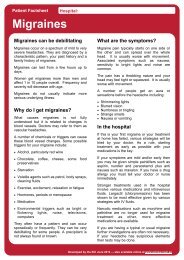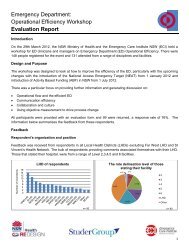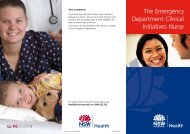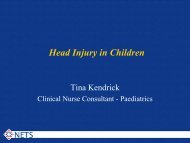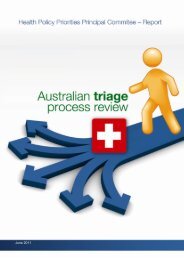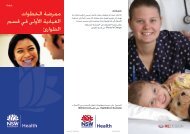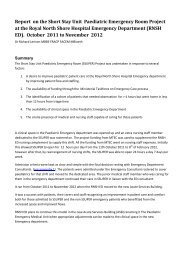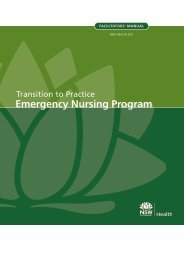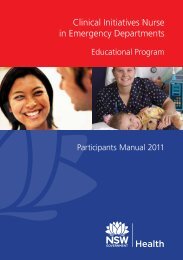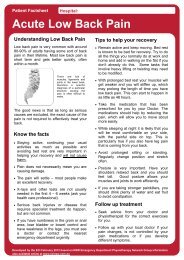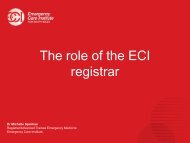Emergency Department Models of Care 2012 - NSW Health
Emergency Department Models of Care 2012 - NSW Health
Emergency Department Models of Care 2012 - NSW Health
- No tags were found...
You also want an ePaper? Increase the reach of your titles
YUMPU automatically turns print PDFs into web optimized ePapers that Google loves.
SECTION 2The ideal ED patient journeyThe Ideal <strong>Emergency</strong> <strong>Department</strong> Journey outlines elementsand principles that support the ideal journey <strong>of</strong> all patientsas they travel through an <strong>Emergency</strong> <strong>Department</strong> (ED) in<strong>NSW</strong>.It is a fundamental and underlying principle that onlypatients requiring the specialist care that an ED can provideshould be managed in an ED. Patients who do not requiremedical assessment or resuscitation, but do require hospitaladmission for further care, should not be admitted via theED. Similarly, patients for whom another community orhospital service can provide the required care should accessthat service directly. In general, transferring patients fromone ED to another for repeated assessment represents aninefficient use <strong>of</strong> health service resources and should beavoided. If a health service, for local reasons, decides to usean ED to provide non-ED services, this must be explicit inservice agreements and the resourcing <strong>of</strong> that ED.The ideal patient journey has been used to develop the newmodels <strong>of</strong> care described in this document. To deliver theideal journey there must be a strict focus on:■■■■■■■■Getting the right patient to the right place for theircare that is supported by the right resources to ensurethe smooth flow <strong>of</strong> patients through the ED.Early assessment and streaming to an appropriate MOCboth within the ED and outside the ED.Designated specialty MOC for patient cohorts.A team approach to patient care.Ensuring tasks are performed by the provider who canmost efficiently perform the task (where ‘efficiency’balances quality, cost and minimising duplication <strong>of</strong>work).Coordinated patient care including between specialistconsultants, diagnostics services and community care.Strong monitoring and evaluation measures.Adherence to the principles <strong>of</strong> the new models <strong>of</strong> care.The ideal journey has several key areas:■■■Beginning the journeyTriage and registrationResuscitation and trauma■■■■■Acute <strong>Care</strong> <strong>of</strong> complex, non-ambulatory, high acuitypatients (see Acute care and 2 : 1 : 1)Early senior assessment and streaming <strong>of</strong> patients toappropriate MOC (see early ED Senior AssessmentStreaming, Clinical Initiatives Nurse)<strong>Care</strong> for lower acuity, complex, non-ambulatory patients(see Sub-acute, Early Treatment Zone)<strong>Care</strong> for non-complex, ambulatory patients (see FastTrack and the currently being piloted ‘Urgent <strong>Care</strong>Centres’)Non- ED models (see Short Stay Units, Medical andSurgical Assessment Units).2.1 Characteristics <strong>of</strong> the Ideal EDPatient JourneyThe characteristics <strong>of</strong> the ideal ED patient journey are part<strong>of</strong> a patient-centric approach to the management <strong>of</strong> patientcohorts. They are aimed at:■■■■■■■■Reducing the delays in the patient journey through earlysenior medical assessment <strong>of</strong> patients, fast tracking andearly initiation <strong>of</strong> clinical care.Providing faster access to care through:− a coordinated team approach to patient care− eliminating duplication <strong>of</strong> processes− reducing unproductive waiting periods− reducing the total time spent in an ED− standardising care to reduce variation for conditionssuch as chest pain.Providing multiple MOC options to assess and treatpatients.Realigning staff roles and resources to establish <strong>Models</strong><strong>of</strong> <strong>Care</strong>.Streaming patients to the correct MOC, reducing theincidence <strong>of</strong> models blocked with inappropriate patientsfor that model.Using designated beds for patients who need a furtherperiod <strong>of</strong> assessment, investigation or observationbefore movement to the next MOC or being dischargedhome.Ensuring that people with minor injuries or illness aretreated and discharged efficiently.Providing appropriate locations outside the ED forPAGE 6 <strong>NSW</strong> HEALTH <strong>Models</strong> <strong>of</strong> <strong>Emergency</strong> <strong>Care</strong>




